
There’s not much we enjoy more than cooking a camp meal with friends. Photo: Carson Brown//The Inertia
Food is the focal point of any good gathering. Camping is no exception. When we’re having a weekend in the woods, we always bring a camping stove so we can cook up a good meal. These days, there are lots of different stove options, including classic two-burner stoves, fire pits, and even portable grills. We tested the best camping stoves to recommend options for every type of camper.
Navigate To: Comparison Table | Buyer’s Guide | Best Backpacking Stoves
Editor’s Note: We updated this guide in October 2024 with a new pick, more testing notes, and improved navigation.
The Best Camping Stoves of 2025
Best Overall Camping Stove: Camp Chef Everest 2X Mountain Series Stove
Best Budget Camping Stove: Coleman Classic Propane Camping Stove
Most Versatile Camping Stove: Jetboil Genesis Basecamp Stove
Best Fire Pit + Stove: BioLite FirePit+
Most Portable Camping Stove: Snow Peak Home & Camp Butane Stove
Best Backpacking Stove: MSR PocketRocket Deluxe
Jump to More Top Camping Stoves
Best Overall Camping Stove
Camp Chef Everest 2X Mountain Series Stove ($190)
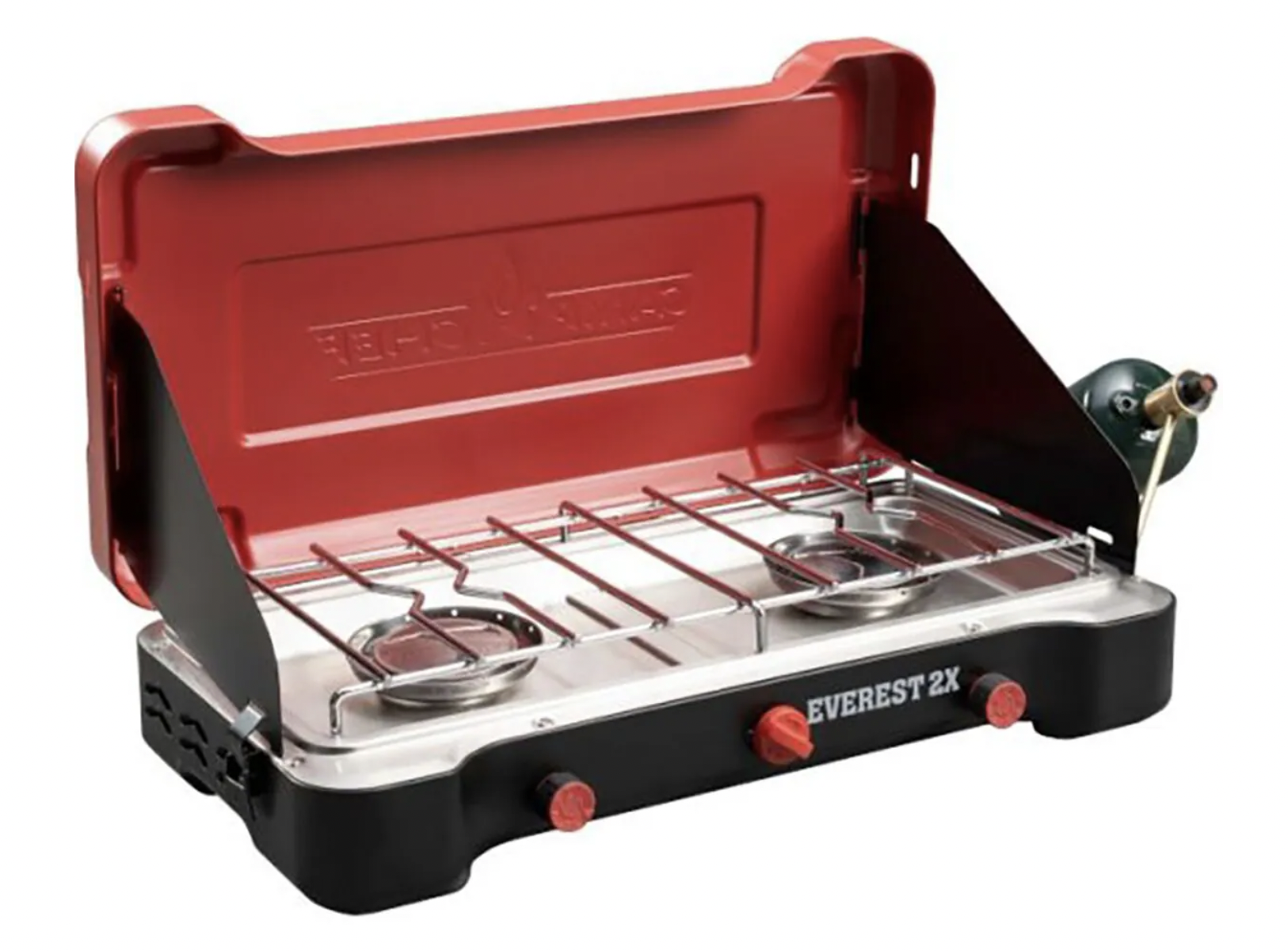
Pros: Push-start ignition, easy to clean
Cons: Must press push-start ignition hard to light
Material: Stainless steel
Fuel Type: Propane
Heat Output (per burner): 20,000 BTU
Claimed Weight: 12 lbs
Dimensions: 25.2 x 12.7 x 5.6 inches
Auto Ignition: Yes
The Camp Chef Everest 2X Mountain Series Stove is a powerful two-burner camp stove. It has two, 20,000 BTU burners and a built-in ignition that is a trip-saver should you forget a lighter. In order to get the flame ignited using the push-start, you have to give it a really solid turn, but it does work well.
The Everest includes a propane cylinder adapter that makes it easy to screw on a propane tank. The stainless steel construction ensures the stove is durable and helps it fare well in bad weather. The flame is adjustable and can burn at high temperatures for boiling as well as low, even temperatures for simmering.
One of our testers likened this stove to the premium package version of Stanley’s classic two-burner. It has everything a classic camp stove does, just designed with more precision and intention. The windscreen clips into a cleverly hinged system on the stovetop. This is a roving gourmand’s dream rig, replicating the power of a home range on the campsite picnic table.
One of our favorite features of the Everest is the integrated, removable drip tray that collects spills. If you’ve ever tried to clean a camping stove, then you know how challenging it is. The drip tray makes camp cooking messes much easier to clean. The Everest also has a three-sided windscreen that can be a little tricky to figure out how to get clipped in, but once you do, it works well. We tested this stove on a couple of windy days on Oahu and it performed well, and the flame never went out. The Everest was our best overall camping stove thanks to its powerful flame, windscreens, push-start ignition, and overall ease of use.
CHECK PRICE ON Amazon Check Price on Cabela's

Power and precision in a classic package: The Camp Chef Everest is our favorite camping stove. Photo: Gerber//The Inertia
Best Budget Camping Stove
Coleman Classic Propane Camping Stove ($75)
Pros: Inexpensive, good temperature control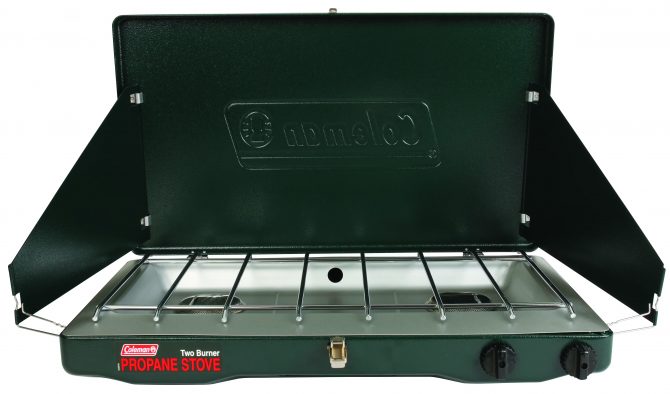
Cons: No push-start ignition
Material: Steel
Fuel Type: Propane
Heat Output (per burner): 10,000 BTU
Claimed Weight: 11 lbs 10 oz
Dimensions: 22.5 x 5 x 14.5 inches
Auto Ignition: No
The Coleman Classic Propane Camping Stove is the definition of old reliable. Even though it’s consistently half the price (or less) of its competitors, the Coleman Classic is a simple, sturdy camping stove capable of cooking up a gourmet meal. While it doesn’t boast the highest heat output or features like a push-start ignition, the Coleman has surprisingly good temperature control and should last for years.
With 10,000 BTU heat output per burner, the Coleman Classic is among the lowest on this list as far as pure power goes. It also doesn’t feature a push-start ignition, so you’ll need to remember a lighter, matches, or some type of striker. However, beyond those small shortcomings, this camping stove just works. The temperature control dials are smooth turning and give far more fine-tuning than expected in such a modestly-priced stove. This precision allows you to effectively simmer or keep food warm on low heat (sometimes difficult to do with high-powered camp stoves). The Coleman Classic has space between its windshields for a 12-inch and 10-inch pan, which is plenty for most of our camp cooking needs. And while the stove isn’t as powerful as our top pick, we found it was fine for quickly boiling water.
One of our editors has had the Coleman Classic Propane Camping Stove for nearly a decade and it still works great (though he did replace a broken pressure regulator). At just $75 at the time of publishing (and often on sale for less), the shortcomings of this camping stove are easy to forget.
Check Price on Coleman Check Price on Amazon

Camp breakfast, cabin breakfast, we don’t care as long as it’s breakfast. Photo: Matt Medendorp//The Inertia
Most Versatile Camping Stove
Jetboil Genesis Basecamp Stove ($400)
Pros: Couples with other Jetboil stoves, compact when packed, works on uneven surfaces
Cons: Harder to clean, windscreen ineffective
Material: Stainless steel
Fuel Type: Propane
Heat Output (per burner): 10,000 BTU
Claimed Weight: 6 lbs 3.2 oz
Dimensions: 9.8 x 4.6 in (packed); 20.5 x 9.8 in (open)
Auto Ignition: Yes
The Jetboil Genesis doesn’t look like other stoves on this list, but that’s a feature, not a bug. The cylindrical stove takes some mental gymnastics to get used to, but it quickly shows its ingenuity.
At 10,000 BTUs it has the power to cook and boil water in ~ 3 minutes. That’s less than Camp Chef’s Everest by half, but still enough to cook with confidence. Two self-ignition levers are simple and intuitive to use and stop the ever-frustrating search for a lighter around supper time.
The Genesis’s best feature is its independent burners that can work on multiple surface heights. Because the two burners are linked by a flexible rubber hinge rather than contained in a steel pan, you can set them up on varied surface heights and still cook with confidence. Two stumps side by side or an uneven hillside won’t pose a problem when cooking up some scrambled eggs on the Genesis.
It pairs best with Jetboil’s range of pots and pans, but will also serve regular or kitchen staples. When one of our tester’s home range broke, he set up the Genesis as a portable cooking station in his house until the repairman could come by.
Compared to other models, the Genesis struggles in the wind. Even with the included windscreen, its innovative design leaves it more vulnerable to gusts and breezes. And it’s tough to clean. There are no removable grates, so spilled meals can be a bear to scrub off.
Despite those drawbacks, it emerges as one of our favorite stoves in the bunch. Our testers swore by the outlink feature, which allows you to pair another Jetboil stove to the Genesis and run it off the same propane tank. This means it’s easy to boil water for morning coffee or evening hot drinks while leaving both burners free for cooking. It’s worth noting that while we tested the “Basecamp” version, you can also purchase just the Genesis Stove (no included pots and pans) for $100 less.
Check Genesis Basecamp Price on REI Check Genesis Stove Price on REI

The Jetboil Genesis Basecamp is splittable, versatile, and surprisingly powerful. Photo: Matt Medendorp//The Inertia
Best Fire Pit + Stove
BioLite FirePit+ ($250)
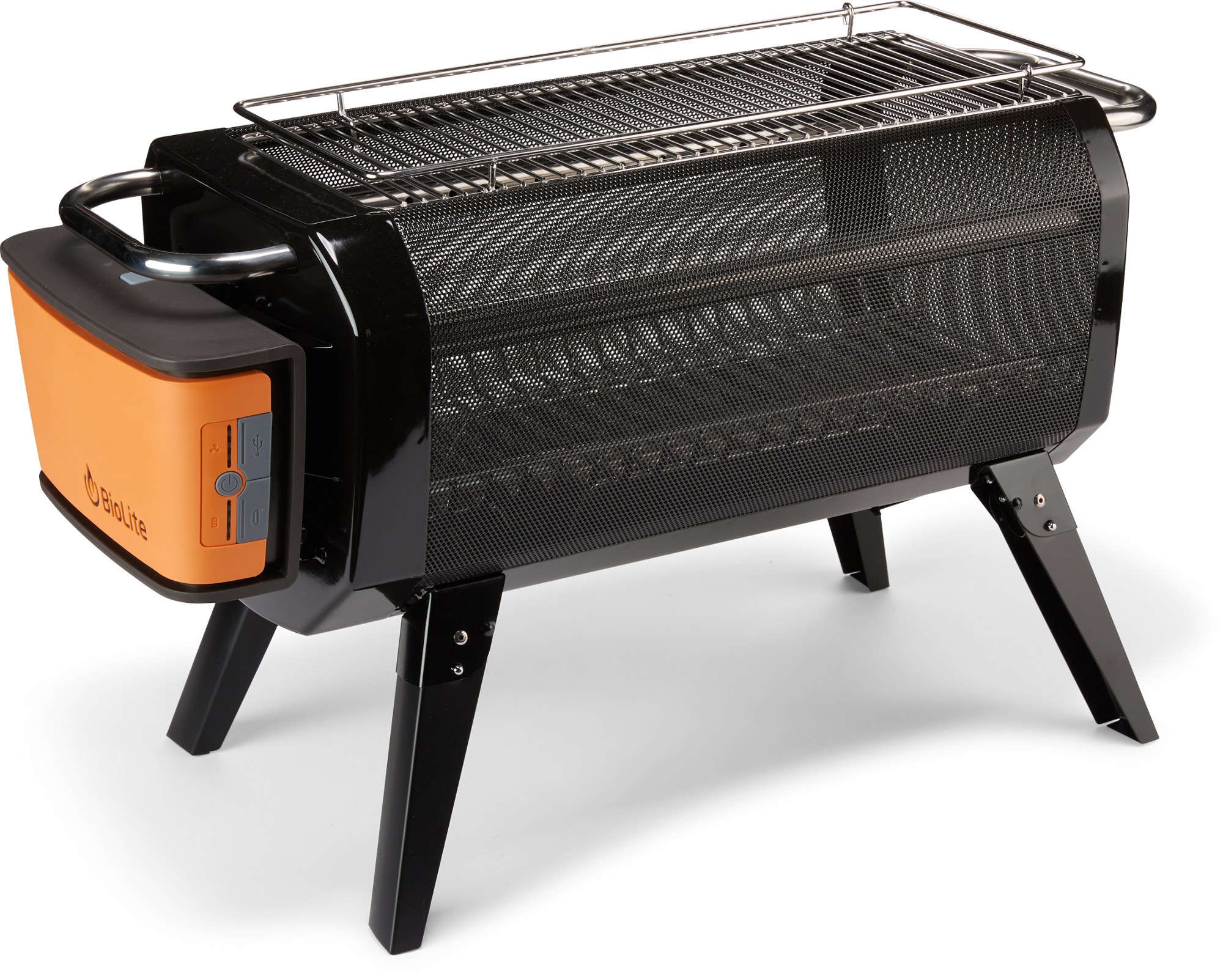
Pros: Burns wood or charcoal, charges phones
Cons: Bulky
Material: N/A
Fuel Type: Wood/charcoal
Heat Output (per burner): N/A
Claimed Weight: 19 lbs 13 oz
Dimensions: 27.5 x 16 x 12 inches
Auto Ignition: No
The BioLite FirePit+ is sure to enhance any camp cooking experience. While the FirePit+ is a portable fire pit, but it has lots of additional features that make it a capable stove option. The FirePit+ burns woods or charcoal and has 51 air jets that inject the fire with air, resulting in a more uniform temperature and even burn across the pit. You can control the size of the flame directly from the fire pit or via bluetooth using an app.
The FirePit+ comes with a battery pack that works for 30 hours on low, 14 hours on medium, or 7 hours on high. Although you can use the fire pit without the battery, you’ll want to charge it before you go camping in order to utilize all of the features. Although the fire pit does emit smoke, you can use the fans to help direct the smoke upwards and away from your face. The base FirePit+ has an adjustable fuel rack as well as a grill grate, so you can grill or cook over an open flame. For even more cooking prowess, though, check out BioLite’s Cooking Kit, too. In addition to the base FirePit+, the Cooking Kit also includes a griddle, grill lid, and prep kit.
The BioLite FirePit+ also has a micro-USB input that you can use to charge your phone. At the end of the camping trip, the legs are collapsible to make it easier to transport. The FirePit+ is certainly bulkier than a traditional camping stove, but it’s nice that it allows you to have a fire in a controlled environment that’s functional beyond the flame.
For more information on the BioLite FirePit+, check out our full review.
CHECK PRICE ON REI Check Price on BioLite
Most Portable Camping Stove
Snow Peak Home & Camp Butane Stove ($120)
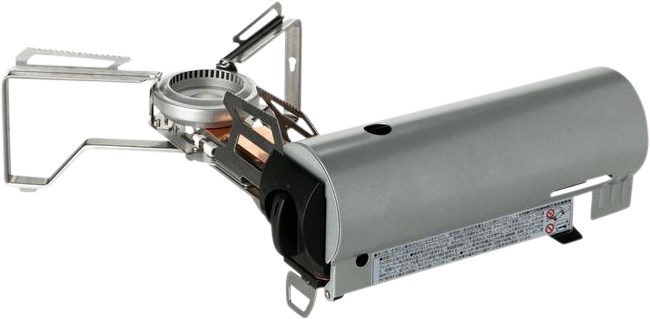
Pros: Lightweight and compact
Cons: Not a long flame life, only has one burner
Material: Stainless steel
Fuel Type: Butane
Heat Output (per burner): N/A
Claimed Weight: 3 lbs
Dimensions: 13.6 x 11.8 x 4.7 inches
Auto Ignition: Yes
The Snow Peak Home & Camp Butane Stove is a compact camping stove that is easy to pack along for all of your adventures. The stove folds into a compact cylinder that is a similar size to a water bottle, so it’s easy to slip into a duffel or backpack. When you’re ready to use the stove, it folds out from its cylinder to offer a single burner stove.
Because of its smaller size, the Home & Camp stove doesn’t offer as strong or as long-lasting of a flame as other stoves on our list. However, it has a push-start ignition and versatile temperature control, so you can readily boil or simmer. Despite its small size, the stove expands to support pots up to 12 inches in diameter. We found that the Home & Camp stove worked well for one or two people, especially if you’re packing your camping gear in a smaller vehicle. The design also makes it easy to keep clean.
CHECK PRICE ON REI Check Price on Amazon
Best Backpacking Stove
MSR PocketRocket Deluxe ($85)
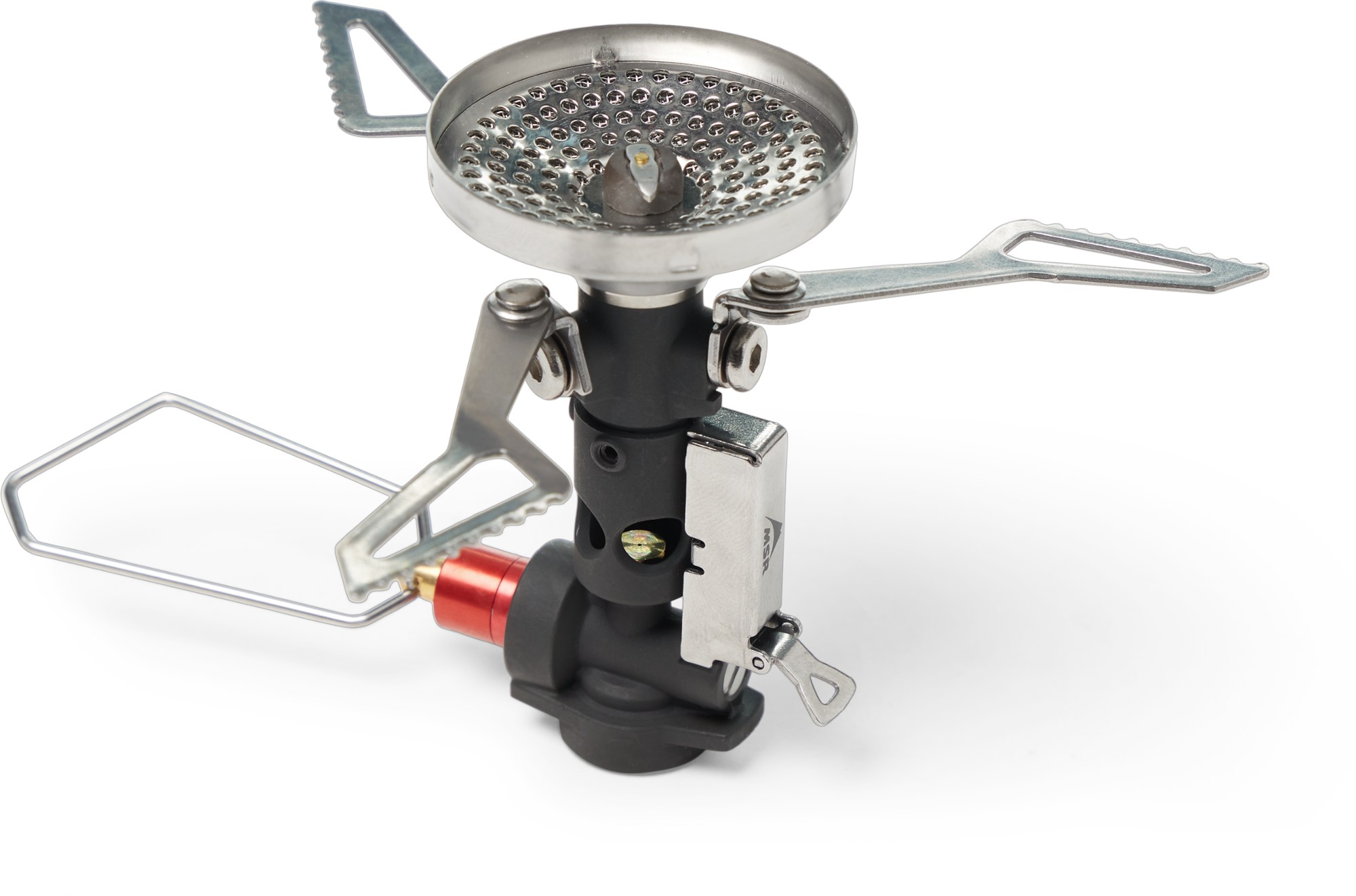
Pros: Push-start ignition, powerful, fine-tuned simmer control, excellent wind performance
Cons: Pricey
Material: Aluminum
Fuel Type: Isobutane-propane
Heat Output: N/A
Claimed Weight: 2.9 ounces
Dimensions: 3.3″ x 2.2″ x 1.8″
Auto Ignition: Yes
The MSR PocketRocket Deluxe is the king of the backpacking stove game (and our top pick from our Best Backpacking Stoves guide). With its even, powerful burner and automatic ignition, this lightweight, compact backpacking stove packs a serious punch.
While we don’t usually car camp with a backpacking stove as our only cooking option, sometimes it’s nice to save space and go minimalist. Of any small backpacking stove we tested, the MSR PocketRocket Deluxe offers the most. Its burner is large for the overall size of the stove, so you can dial in the heat control well. Plus, the arms hold a decent-sized pot or pan. While it’s not the only stove we’d use if we were cooking for a group at camp, it’s our favorite backpacking stove and makes a great option if you only want to buy one that can be used for both backpacking and camping.
For more information on the MSR PocketRocket Deluxe, read our full review.
CHECK PRICE ON REI Check Price on Amazon
More Top Camping Stoves
Most Unique Camping Stove
BioLite CampStove 2+ Complete Cook Kit ($250)
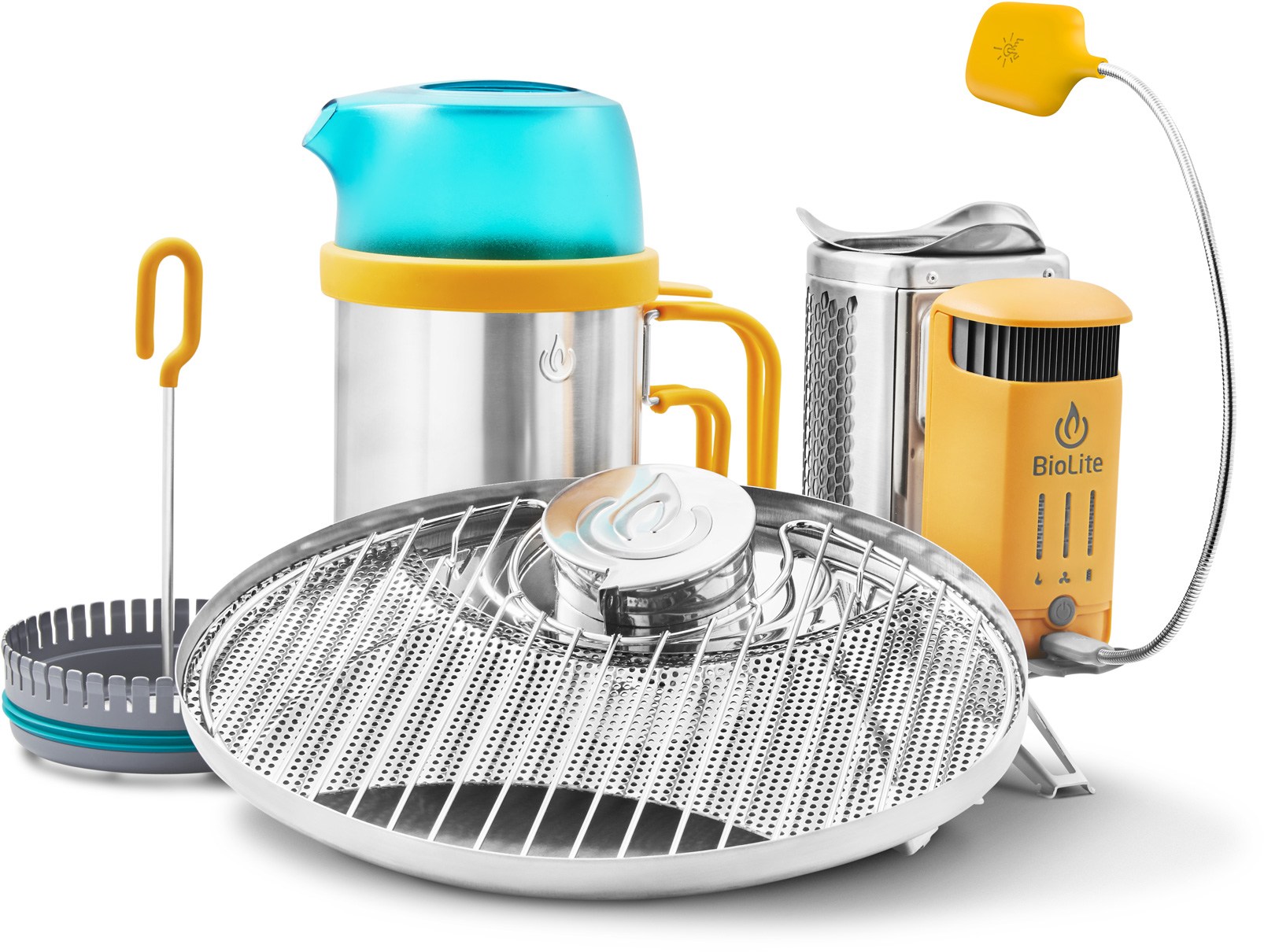
Pros: Multiple cooking options, will charge small electronics
Cons: Can be difficult to achieve a consistent flame
Material: Steel
Fuel Type: Wood
Heat Output (per burner): 10,000 BTU
Claimed Weight: 5 lbs 3.6 oz
Dimensions: 5 x 8.75 inches
Auto Ignition: No
The BioLite CampStove 2+ was hands down the most unique camping stove on our list. Instead of propane as a fuel source, the CampStove 2+ uses wood or any dry biomass including sticks, pinecones, and BioLite BioFuel pellets. We thought this was a really cool feature, especially if you’re in a bind and don’t have access to fuel.
Because you’re essentially building a fire inside the stove, we found that it took a while to get a consistent flame going that was suitable for cooking. At first, we were doubting whether the CampStove 2+ would actually work well for cooking but once we built up a consistent flame it did. The stove has built-in fans that help you control the power of your cooking flame. Although we liked that the stove burns wood, we wish there was also an option to charge it or use traditional fuel in case you’re striking out with finding dry wood.
The CampStove 2+ Complete Cook Kit is a versatile setup that functions as a camping stove, portable grill, kettle, coffee press, and light. It also will charge small devices like your phone. We enjoyed having lots of different options and used the stove to cook as well as make our morning coffee. The CampStove2+ is lightweight, durable, and portable, and it’s an innovative way to cook at the campsite.
CHECK PRICE ON REI Check Price on Amazon Check Price on BioLite
Best Camping Stove For Large Groups
Camp Chef Pro 16 Cooking System ($350)
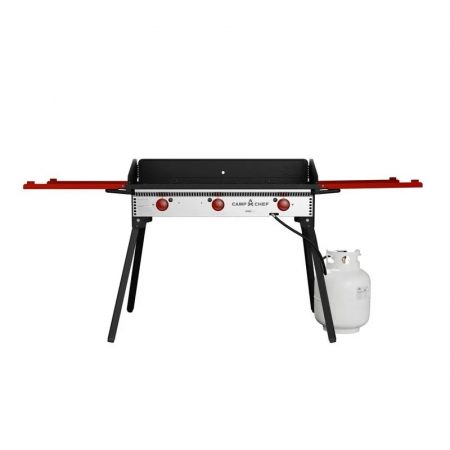
Pros: Capable of cooking for a crowd, lots of accessories
Cons: Large and heavy
Material: Aluminum
Fuel Type: Propane
Heat Output (per burner): 30,000 BTU
Claimed Weight: 49 lbs 8 oz
Dimensions: 16 x x 38 x 36 inches
Auto Ignition: Yes
Editor’s Note: We tested the Camp Chef Pro 14, which is no longer in stock on Camp Chef. The Pro 16 is very similar, but features 3 burners instead of 2. The Pro 14 and Pro 16 were formerly named the “60X” and “90X”, so we’ve included links to both. The stoves are functionally the same.
The Camp Chef Pro Cooking System is by no means a small or compact camping stove option. It’s essentially a backyard grill but a little more lightweight and portable. The legs fold up and the side shelves fold in to help with transportation, but we think this “camping stove” is best suited to RV camping or longer camping trips (ideally with a pickup truck).
The Pro 16 has three high-powered, 30,000 BTU burners that boil large pots of water super fast or produce an excellent sear on meats. The system has a push-start ignition and a three-sided windscreen which our tester really appreciated in consistent Oahu winds. The grill is also compatible with a lot of accessories like griddles, BBQ boxes, pizza ovens, cast iron, and more, so you can use it for a wide array of meals. A standout feature of this Camp Chef unit is the leg levers that are adjustable to accommodate uneven ground—a huge help with such a sizable stove. The Pro series is the perfect option when cooking for large groups of campers, and is best suited to families, camps, or similar gatherings.
CHECK PRICE ON Camp Chef Check Price on Backcountry
Check Pro 14 Price on BackcountryGSI Outdoors Selkirk 540+ Camp Stove ($150)
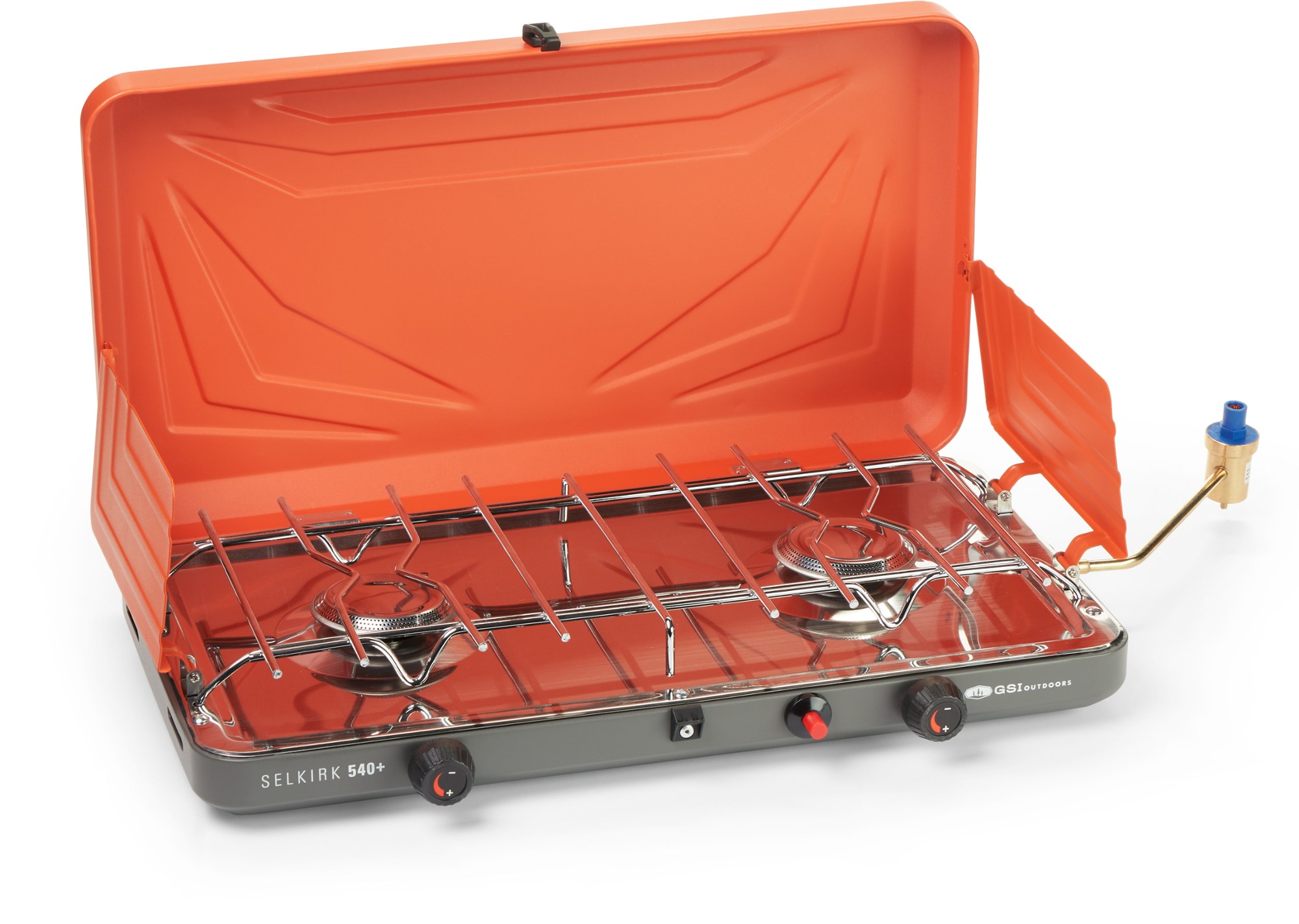
Pros: Compact design, windscreens
Cons: Not as powerful as similar stoves
Material: Steel
Fuel Type: Propane
Heat Output (per burner): 14,000 BTU
Claimed Weight: 10 lbs
Dimensions: 21.4 x 12.9 x 3.8 inches
Auto Ignition: Yes
Of all the camping stoves we tested, the GSI Outdoors Selkirk 540+ Camp Stove was the most portable for a classic two-burner stove. Measuring 21.4 x 12.9 x 3.8 inches, it has a slim profile, making it easier to stash in the car when you’re heading out camping with the family. And at 10 pounds, it’s on the light end for a two-burner camp stove.
The Selkirk features a push-start ignition and carrying handles, so you can get a good grip as you push it to get the flame going. The 14,000 BTUs per burner ensure a generous flame that allows you to boil water and cook at low temperatures. The flame isn’t as powerful as a stove like the Everest 2X, but it was reliable and sufficient. The stove has small windscreens on the sides, which helps with gusts. The stainless steel construction makes the stove sturdy and durable. Finally, the removable pot supports make for easy cleanup. Simple and easy to use, the Selkirk is a family-friendly camping stove at a solid price. All things considered, we still prefer the value of the Coleman or the power of the Camp Chef Everest, but for some, the GSI Outdoors Selkirk 540+ strikes a nice balance between the two.
CHECK PRICE ON REI Check Price on Amazon
Solo Stove Bonfire Cast Iron Griddle Cooking Bundle 2.0 ($495)
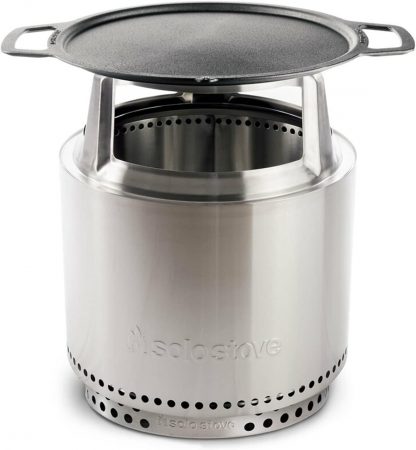
Pros: Straightforward design, removable ash tray for easy cleaning
Cons: Get really hot, large to store/transport
Material: Stainless steel
Fuel Type: Wood
Heat Output (per burner): N/A
Claimed Weight: 44 lbs 6 oz (with cooking hub)
Dimensions: 19.5 x 14 inches
Auto Ignition: No
If you like to have a roaring (and mostly smokeless) fire when you’re camping, the Solo Stove Bonfire Cast Iron Griddle Cooking Bundle 2.0 is a great pick. The Bonfire is a large stainless dual-wall, stainless fire pit. It features a smokeless design that, when fully burning, produces a very low-smoke fire. With the cooking hub and cast iron griddle, the Solo Stove evolves into a fun and functional camp stove.
The cooking bundle (which features a raised hub and cast iron griddle or grill) sits on top of the Bonfire and leaves enough space to keep tending the fire beneath. We found that, as long as your wood was split into small-ish pieces, you could keep the flame going well underneath the hub.
We opted for the griddle due to its versatility; with a bit of pre-heating, we found that the griddle produced consistent heat. If you over-stoke your fire, you will notice that the cast iron gets hot, but that is useful for quick-searing meats. The only drawback of the cooking bundle is that it’s difficult to achieve different cooking zones (in effect, this functions like a single-temperature griddle). That said, for eggs, meats, and other straightforward foods, the Solo Stove Bonfire Cooking Bundle 2.0 is a lot of fun to use. Everything (except for the flat griddle pan) packs neatly into the pit itself when heading home.
Editor’s Note: If you already have a Solo Stove Bonfire Pit, you can buy the cooking hub separately.
Check Price on Solo Stove
The Solo Stove with a Cooking Hub is a fun way to turn your smokeless pit into a camp kitchen. Photo: Matt Medendorp//The Inertia
Snow Peak Teppanyaki Burner ($270)
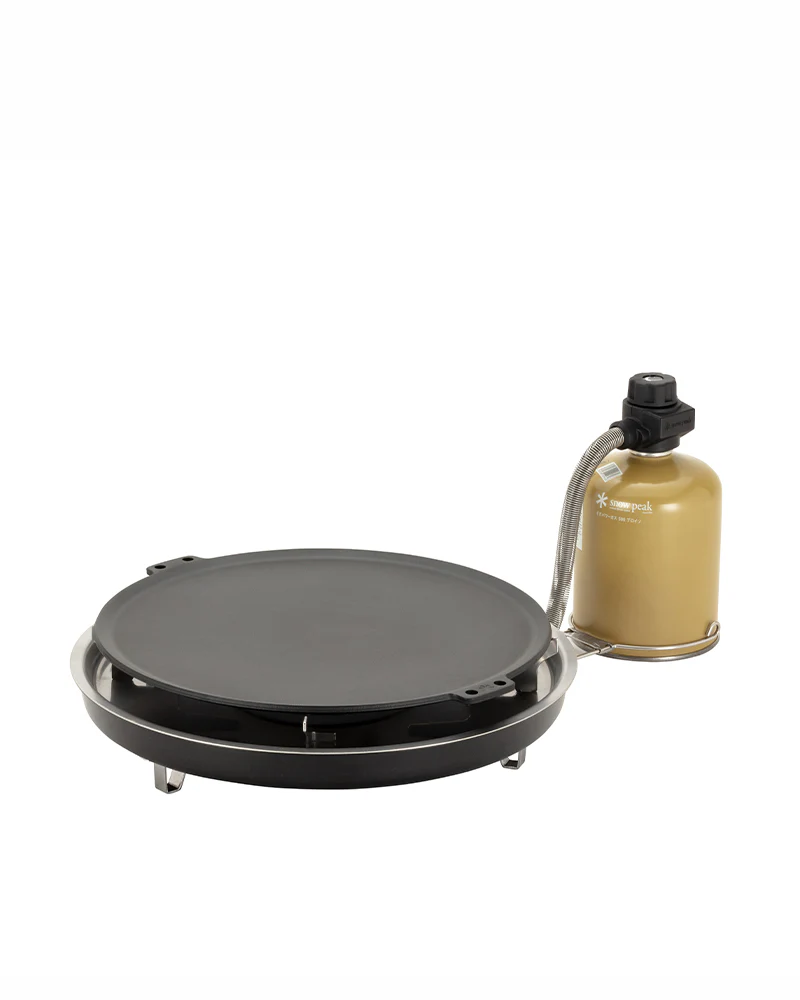
Pros: Hot plate is great for grilling, easy to use
Cons: Only one burner
Material: Stainless steel and aluminum
Fuel Type: Iso-Butane
Heat Output (per burner): 10,310 BTU
Claimed Weight: 11 lbs
Dimensions: 14″ x 12.9″ x 3.5″ inches
The Snow Peak Teppanyaki Burner is different than most camping stoves, but is a great option to have. The Teppanyaki Burner is essentially a hot plate that attaches to a fuel canister. The stove includes a removable iron plate that’s great for grilling and cooking teppanyaki on, a classic stove burner, and a cartridge guard.
Our testers loved how simple and easy this stove is to use. While most camping meals are cooked in a pot or pan, it was fun to grill directly on the hot plate and cooked one of the tastiest camping meals we’ve ever had. We also found that the Teppanyaki Burner was a great option to use at home as well. At the end of the day, the entire stove packs down into a storage bag for organized storage and easy transport.
CHECK PRICE ON REICheck Price on Backcountry
Best Camping Stoves Comparison Table
| Camping Stove | Cost | Material | Fuel Type | Heat Output (per burner) | Weight | Dimensions | Auto Ignition |
| Camp Chef Everest 2X Mountain Series Stove | $190 | Stainless steel | Propane | 20,000 BTU | 12 lbs | 25.2 x 12.7 x 5.6 inches | Yes |
| Coleman Classic Propane Camping Stove | $75 | Stainless steel | Propane | 10,000 BTU | 11 lbs 10 oz | 22.5 x 14.5 x 5 | No |
| BioLite CampStove 2+ Complete Cook Kit | $250 | Steel | Wood | 10,000 BTU | 5 lbs 3.6 oz | 5 x 8.75 inches | No |
| BioLite FirePit+ | $250 | N/A | Wood/charcoal | N/A | 19 lbs 13 oz | 27.5 x 16 x 12 inches | No |
| Snow Peak Home & Camp Butane Stove | $120 | Stainless steel | Butane | N/A | 3 lbs | 13.6 x 11.8 x 4.7 inches | Yes |
| MSR PocketRocket Deluxe | $85 | Aluminum | Isobutane | N/A | 2.9 oz | 3.3 x 2.2 x 1.8 inches | Yes |
| Camp Chef Pro 16 Cooking System | $350 | Aluminum | Propane | 30,000 BTU | 59 lbs 8 oz | 16 x x 38 x 36 inches | Yes |
| GSI Outdoors Selkirk 540+ Camp Stove | $150 | Steel | Propane | 14,000 BTU | 10 lbs | 21.4 x 12.9 x 3.8 inches | Yes |
| Solo Stove Bonfire Cast Iron Griddle Cooking Bundle 2.0 | $495 | Stainless steel | Wood | N/A | 44 lbs 9 oz | 19.5 x 14 inches | No |
| Snow Peak Teppanyaki Burner | $270 | Stainless steel & aluminum | Isobutane | 10,310 BTU | 11 lbs | 14 x 12.9 x 3.5 inches | No |
How We Tested Camping Stoves
Our team has a lot of experience sleeping in a tent and cooking on camping stoves. Spearheaded by testers Rebecca Parsons and Matt Medendorp, we have taken these stoves on everything from summer equinox camping trips in Alaska’s islands to sprawling, family camp set-ups in the woods of Michigan to beach-side cookouts on Oahu.

A few of the camping stoves we tested. Photo: Rebecca Parsons//The Inertia
In preparation for this guide, our testers took camping trips to test out all of the stoves on our list. Through our testing, we boiled water, made coffee, grilled pizzadillas, cooked pancakes, made hash-browns, and even baked cast iron banana bread. To supplement these trips, our testers often forewent their fully stocked home kitchen and set up several stoves in the backyard, comparing water boiling times and simmer settings in head-to-head tests.
We took into consideration how easy each stove was to set up and get lit, how much heat each produced, and how evenly they cooked food. We also considered the cooking space and stability, and how easy each stove was to clean and pack up at the end of the trip. In addition to testing these stoves on a primary weekend camping trip, our lead tester used some of the stoves at home as well as on a short camping trip with the family. Some picks in this guide have been tested for years by our team.

Food is part of the fun: testing camping stoves with friends. Photo: Rebecca Parsons//The Inertia
Camping Stoves Buyer’s Guide
Types of Camping Stoves
Although camping stoves come in many shapes and sizes, there are two main types of camping stoves: stand-alone remote-fuel and free-standing.
Stand-Alone Remote-Fuel
Most camping stoves are stand-alone remote-fuel stoves. Unlike backpacking stoves, stand-alone stoves don’t require the fuel canister to support the stove. On stand-alone stoves, the fuel canister typically screws onto the side of the stove. In order to use a stand-alone stove, you’ll want to place it on a table, the ground, or any flat, non-flammable surface, and then attach the canister. The Camp Chef Everest 2X Mountain Series Stove and GSI Outdoors Selkirk 540+ Camp Stove are examples of stand alone stoves.

The BioLite FirePit+ is a free-standing camping stove. Photo: Rebecca Parsons//The Inertia
Free-Standing
Free-standing stoves are completely self-supported and have legs that allow them to stand upright. These camping stoves typically have higher energy outputs and are capable of cooking for larger groups. Examples of freestanding stoves include the Camp Chef Pro 14 Cooking System and the BioLite FirePit+.
Fuel Source
Where once camping stoves almost all relied on propane for fuel, these days there are multiple options. For this guide, we tested camping stoves that used propane, Iso-Butane, Butane, and wood.

Cooking up something good on a camping stove. Photo: Rebecca Parsons//The Inertia
Propane
The most common fuel source among the stove we tested was propane. Although the amount of time a one-pound canister of propane will last depends on how many burners your’e using, how high you have the heat turned up, and how long you’re cooking, a typical can will last for about an hour. In our tests, this translated to three of four full meals. If you’re heading out for more than one night, it’s a good idea to bring multiple cans of propane with you. Propane is considered an all weather type of fuel and works well in most conditions but it can get a little funky when it’s too cold. And if you (like us) hate figuring out what to do with empty propane cans, consider a small refillable tank with an adapter hose.

The Snow Peak Teppanyaki Burner is fun to use at the campsite or at home. Photo: Rebecca Parsons//The Inertia
Butane
Butane is the cheapest fuel source. It has a low boiling point and low vapor pressure, meaning it tends to work best in warmer weather. One of the best things about butane is that is has high energy content and clean burning properties.
Isobutane-Propane
A mix of butane and propane, isobutane-propane is a popular choice among backpackers, but it’s used for some camping stoves as well. Isobutane-propane is known for being lightweight and it comes in various size options. It also has a higher boiling point than butane. However, isobutane doesn’t work well as propane at high altitudes and it doesn’t work well below 14 degrees Farenheidt. Isobutane-propane also isn’t compatible with most camping stoves but there are exceptions like the Snow Peak Teppanyaki Burner.

Wood burning fire stoves like the BioLite FirePit+ are great for grilling. Photo: Rebecca Parsons//The Inertia
Wood
If you’re camping in an area that permits wood fires, wood can be a great fuel option. A huge perk of using wood is that it’s readily available, more renewable, and eliminates the need to carry canisters to and from camp. However, wood-burning camp stoves can be difficult to get lit, especially if it’s been raining. If you’re using a wood-burning stove it’s always a good idea to bring an alternative fuel source with you.
What Makes A Good Camping Stove?
Burners
Most camping stoves come with either one or two burners. If you’re cooking for just yourself or a few other people, a single-burner stove can be fine. It’s also important to note that single-burner camping stoves work best for one-pan meals, otherwise you’ll have to cook step by step. Two-burner stoves work well for larger groups or if you plan on cooking multiple dishes at the same time. Unless you’re tight on space, we always prefer a two-burner stove as it expands your possibilities.

The The Camp Chef Everest 2X Mountain Series Stove is a powerful two-burner camp stove that delivers 20,000 BTU per burner. It has a push-start ignition, wind screens, and is easy to use.
Auto-Ignition
Auto-ignition is a game changer when it comes to camping stoves. It eliminates the necessity of matches or a lighter and allows you to get your stove lit with the push of a button. We have found that modern auto-ignitions are reliable, but we always recommend bringing some sort of lighter or striker with you, just in case.

Push-start auto-ignitions make everything easier. Photo: Rebecca Parsons//The Inertia
Wind Performance
Growing up, we remember having camping stoves that would constantly blow out in the wind. We had to stack other gear to protect our precious flame. Luckily, most modern camping stoves come with built-in windscreens.
Typically, windscreens are small metal flaps attached to the sides of a camping stove that help wall in your burner flame. Our lead tester lives on Oahu where there is no short supply of wind. She was impressed with how well all of the stoves on our list performed in the wind. If you plan to camp in an area that is windy, make sure you opt for a stove with a windscreen.

Wind screens help keep the burner going even in windy camping conditions. Photo: Rebecca Parsons//The Inertia
BTUs
BTU stands for British Thermal Unit and is used to measure energy output. If you want to get technical, one BTU is the amount of heat needed to raise the temperature of one pound of water by one degrees Farenheidt. One BTU is roughly equal to the energy release of burning a match. The higher the BTUs, the more energy (in the form of heat) a stove can produce. We’ve found that anything over 10,000 BTUs is sufficient for a versatile camping stove.

The Camp Chef Pro 14 Cooking System has a heat output of 30,000 BTUs. Photo: Rebecca Parsons//The Inertia
Weight
When you’re car camping, weight isn’t as big of an issue was when you’re backpacking. However, if you have to walk to your campsite or have limited car space, you’ll want something that’s on the lighter, more compact side. The stoves on our list range from 3 pounds to nearly 50 pounds, so there’s quite a range of available sizes. Typically, heavier camping stoves will have more features and offer more powerful burners, making them better suited to cooking for larger groups.

The BioLite CampStove 2+ Complete Cook Kit is compact and burns wood. Photo: Rebecca Parsons//The Inertia
Packed Size
Similar to weight, packed size isn’t as important when car camping. However, if you’re tight on space, both for storing and transporting, it can be nice to have a stove with a sleeker profile. Some stoves like the Camp Chef Pro 14 Cooking System and the BioLite FirePit+ are larger stoves, but they have collapsible legs that help cut down on their size for storing and transporting. Our team loves classic two burner camping stoves due to their balance of packed size, weight, and heat output.

A mess on the picnic table is a sure sign of a successful camp meal. Photo: Justine Montigny//The Inertia
Fuel Efficiency
Fuel efficiency is dependent on a few factors. The number of burners being used as well as the temperature you’re cooking at will effect your fuel efficiency. Wind can also play a role as your flame will need to work harder in windier conditions. Naturally, more burners being used at higher temperatures will burn through your fuel more quickly. Some stoves list how long they’re able to burn for on a canister of fuel but with others, you’re on your own. Naturally, bigger fuel canisters will result in the ability to cook longer.

Making hash browns on the GSI Outdoors Selkirk 540+ Camp Stove. Photo: Rebecca Parsons//The Inertia
Boiling Power vs. Simmer Control
Boiling power and simmer control are two very different things. The most essential function of a camping stove is its ability to boil water but unlike most backpacking stoves, most camping stoves work well to both boil water and simmer. We look for a camping stove that has a precise temperature dial, so we can cook a variety of foods at camp.
Boiling
Of all the stoves on our list, the Camp Chef Pro 14 Cooking System was capable of boiling water the fastest, thanks to its 30,000 BTUS of heat output. Smaller stoves like the BioLite CampStove 2+ Complete Cook Kit took significantly longer. Generally speaking, we found that most camping stoves took anywhere from three to 10 minutes to boil water. Fast is great, but sometimes a powerful stove that boils water quickly won’t work as well for cooking at lower temperatures.
Simmering
When you’re simmering or doing any type of cooking at a lower temperature, you’ll want a stove that distributes heat evenly. In addition to boiling water, we cooked hash browns, made a cast iron banana bread, and made pancakes on our stoves so we got to see how they worked at lower temperatures. The Camp Chef Everest 2X Mountain Series Stove took the win for our overall best stove because it boils water efficiently but the broad burner heads do a great job of distributing heat evenly for cooking at lower temperatures.
Return to Comparison Table | Return to Top Picks
Editor’s Note: Need a lighter stove for backpacking? We reviewed the Best Backpacking Stoves. For more gear reviews and coverage on The Inertia, click here.




